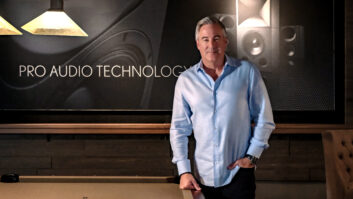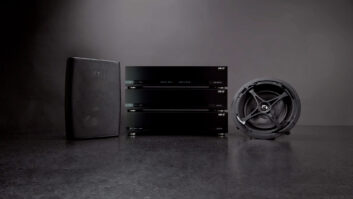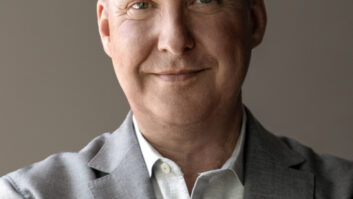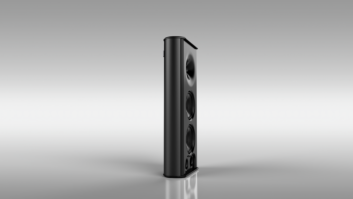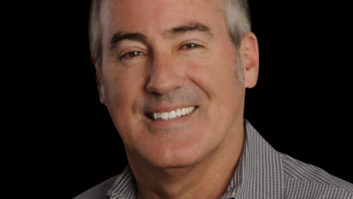Kudos: Incredible dynamics and massive SPL; fast and simple setup; build and performance quality throughout the line
Concerns: Don’t call it a soundbar; size could be an issue in some installs
Let’s cut right to it: The Theory Audio Design soundbar is hands down the best soundbar surround system I’ve ever heard.
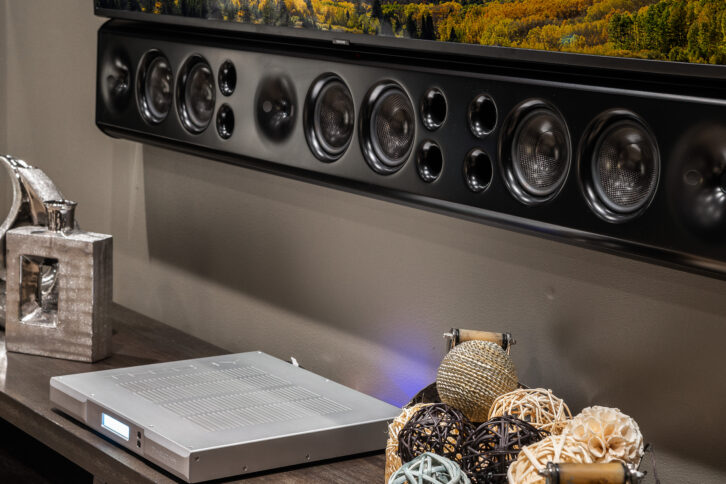
But I’m actually loath to even call it a soundbar, since that pigeonholes what it is and what it is capable of doing in peoples’ minds. When people hear the word “soundbar” they typically picture a thin, self-amplified speaker packaged with a wireless subwoofer and maybe some soda-can-sized surround speakers, and the Theory solution is not even remotely in this same universe — not in looks, design, price, and especially performance.
Really, what Theory sells is a complete surround audio system that just happens to be available in a soundbar formfactor. (Albeit, a soundbar that is likely bigger and heavier than anything the category has ever seen, with even the smallest Theory offering dwarfing the Sennheiser AMBEO, a bar that heretofore held the title of MOAB — Mother of All Bars.)
In a previous review, I noted there are essentially three kinds of soundbar customers: the person looking to improve the TV’s anemic audio, the person wanting better sound but not the complexity and components of an actual surround system, and the person who would love a true surround system but can’t install one for some reason.
Theory introduces a fourth customer: the one that needs/wants a soundbar formfactor for their front channels, but absolutely refuses to compromise on performance anywhere in the audio system. That is who is this for.
Who is Theory?
If you’ve cruised the sound rooms at a CEDIA Expo in the past few years, then you’ve likely encountered Theory Audio Design. They are the booth with the larger-than-life soundbars sitting out front, along with a line to get inside to hear the demo.
Every Theory demo I’ve sat through has been conducted by company founder, president, and designer Paul Hales, and they have always left me impressed with the system’s dynamics and sheer SPL output. And how many other companies choose to demo Kraftwerk in Dolby Atmos?
Hales founded Pro Audio Technology (PRO) in 2004, which manufacturers professional-style loudspeakers and DSP amplifier/processors intended for large private cinemas, as well as high-end dedicated theater rooms and even commercial spaces. These are massive speakers designed to sit in a baffle wall and produce prodigious amounts of output regardless of room size. Awesome to be sure, but probably not something that would be appropriate for 99 percent% of your installs.
In 2018, Hales started Theory to bring the budget and performance down to systems that could be used in a wider range of installations while still retaining much of the PRO philosophy and DNA.
The company first demonstrated at CEDIA Expo in 2018, and started shipping product in 2020 – right before the pandemic shut everything down – and then returned to CEDIA in Dallas in 2022.
If you have an interested client, Theory and PRO have an Experience Center in Lake Forest, Calif. (in Orange County), where systems from both brands can be experienced first-hand in a variety of settings.
The System
Theory does not bludgeon you with a huge portfolio of products. Rather, as they say, “You simply don’t need hundreds of speakers and amplifiers to choose from for your projects, you just need a handful of extremely capable models that can do everything and go everywhere, and that you can trust.”
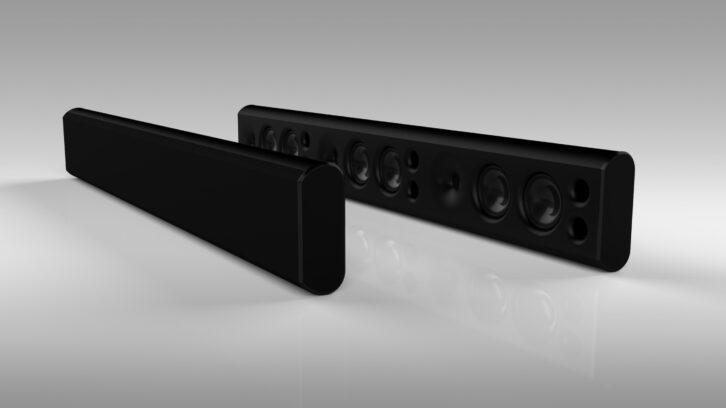
To that end, they have a line with very little fat in it; every product is there to serve a specific purpose. There is no good, better, best offering; rather, everything is best, and all products are designed to work seamlessly together as part of a whole, sharing the same drivers throughout the line.
On the speaker side, there is the sb-series, which I’d say stands for “soundbar” except the smallest sb25 belies that description. The sb25 can be used in a traditional LCR array around a display and, at only 3.8 inches deep, is easily wall-mounted. The actual soundbar-not-soundbar speakers are the sb65, 75, and 85, which are designed to match the width of similar-sized displays.
The sb25 includes two 5-inch Theory Carbon Fiber drivers and one 1.4-inch Theory Advanced Polymer high-frequency compression driver with extension up to 23 kHz, and the sb65/75/85 are essentially three of these mashed together, including a total of six 5-inch drivers and three 1.4-inch compression drivers in a single-cabinet LCR layout.
Performance-wise, three sb25’s would deliver better channel separation between speakers, and the sb75/85 both feature a port to slightly extend bass response over the sb65, but for practical purposes, these speakers all sound the same and share virtually identical performance, especially when bass management is factored in.
Theory also features two architectural models, the iw25 and the ic6. The iw25 is a large, rectangular, in-wall design that features the same driver layout and configuration as the sb25 and will fit in a standard 2×4, 16-on-center stud wall. The ic6 is an in-ceiling design with a 6.5-inch carbon fiber coaxial driver and 1.4-inch compression tweeter, that includes both round and square bezel-less grilles and requires 8.6 inches of mounting depth.
As mentioned, performance, dynamics, and voicing are consistent throughout the speaker line, so you can design a system using as many on-wall, in-wall, or in-ceiling speakers as required and know that there won’t be any performance hit anywhere in the chain.
What you can expect the speakers to deliver is very wide, 125-degree conical coverage, with incredibly flat performance across their frequency range, very smooth and predictable off-axis performance, and highly sensitive drivers that can deliver immense SPLs, up to 124 dB peaks. (To be fair, the ic6 only peaks at 118 dB…)
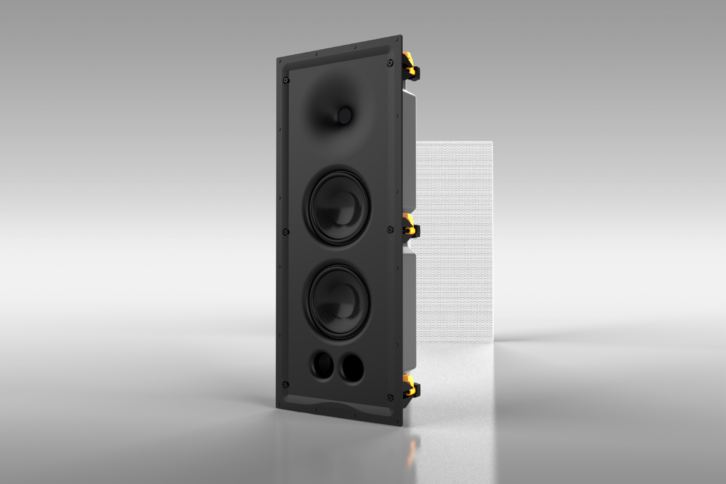
As the speakers throughout the line generally play down to about 54 Hz (68 Hz for the ic6), you’re going to need a sub (or two, or four…) to augment the lowest foundation of the audio spectrum, and Theory has you covered here, as well. In traditional, free-standing models, it offers the sub12 and sub15. These are both passive models featuring 12- and 15-inch drivers with 3-inch voice coils. While they are both rated to play down to 22 Hz, the 15-inch is a tad more sensitive and can handle up to 1000 watts continuous power to deliver peaks up to 130 dB!
If an in-room sub won’t fit your design, Theory offers its iws12-6 architectural in-wall or iws12-9 in-ceiling sub. Both designs utilize the same iws12 speaker assembly, so they achieve similar performance, however, they utilize different enclosures for flexibility. This is a 12-inch driver with 4-inch voice coil capable of playing down to 24 Hz and delivering peaks of 124 dB. The iws 12-6 enclosure requires a 2×6 wall for its 5.5-inch depth, and stands 60 inches high, while the iws12-9 sits in an enclosure measuring 34 x 14 x 9.85-inches (H x W x D).
Consistent, flagship performance is presented throughout the line, where you pick the speakers based on the application or design without sacrifice.
As mentioned, Theory isn’t so much a speaker package as it is an entire surround system, and the company wants you to think of its speakers as active, only instead of the amplification being located in the speaker, it is located in the Theory Amplified Loudspeaker Controller, the ALC-1809.
Theory describes the ALC-1809 as an “audio Swiss Army Knife,” saying the product combines the functionality of five products into one: a multichannel DSP processor, high power multichannel home amplifier, multichannel mixing amplifier, multichannel bass manager, and high-resolution loudspeaker processor.
Beyond a buttload of power — 1800 watts total power on board the 1U, 13-pound device — there is also a lot of proprietary 96 kHz/32-bit DSP onboard to process the audio signal in a very high degree of precision for its loudspeakers and subwoofers. The benefit of the outboard ALC is that it lets you run wiring as you would traditionally, and it keeps the electronics out of the loudspeakers themselves, making them far easier to service if needed.
Also, because it is a system, the ALC is doing the amplification and DSP processing knowing exactly what the speaker on the other end is capable of, thus ensuring the very best performance.
What doesn’t the Theory do? Well, any of the chores of a traditional pre-amp/surround sound processor. In order for the system to function, you’ll need to install your preferred SSP (Trinnov, Storm, Anthem, Marantz, etc.) ahead of the ALC. The company prefers the processor use balanced XLR outputs for best performance. However, you could run the system with a processor/receiver that only offered RCA outputs, as long as you use RCA-to-XLR adapters that have XLR pin-2 hot, and XLR pins 1 and 3 tied together and to RCA ground.
For my review, Theory included an Anthem AVM-70 with XLR outputs they generally use for shows and demos.
Setup
Even though I’d seen Theory systems in person multiple times, I still wasn’t prepared for the enormity of the sb75, which arrived in a box that stood nearly as tall as me. (For the record, I’m 6 feet, 3 inches.) And remember — this is the middle-sized bar. Unboxed, the bar measures 9.5 x 66 x 3.8 inches (H x W x D) and weighs 68 pounds. (The sb65 is 57 inches wide and the sb85 is 72 inches. Height and depth dimensions are the same.)
Removing the sb75 from the box allows you to immediately appreciate its build quality. The speaker features a machined and extruded aluminum housing with a nice, rounded top and bottom in a dark charcoal gray color. Beyond being perfectly inert, it is also extremely durable. In a collision between the speaker and anything else, I’m picking the speaker.
The drivers are arrayed with the tweeters positioned at the far left and right for the most channel separation. Instead of a D’Appolito array, with the center tweeter positioned between its two drivers, the drivers are all arranged in a woofer/woofer/tweeter configuration, which slightly offsets the center channel tweeter to the right.
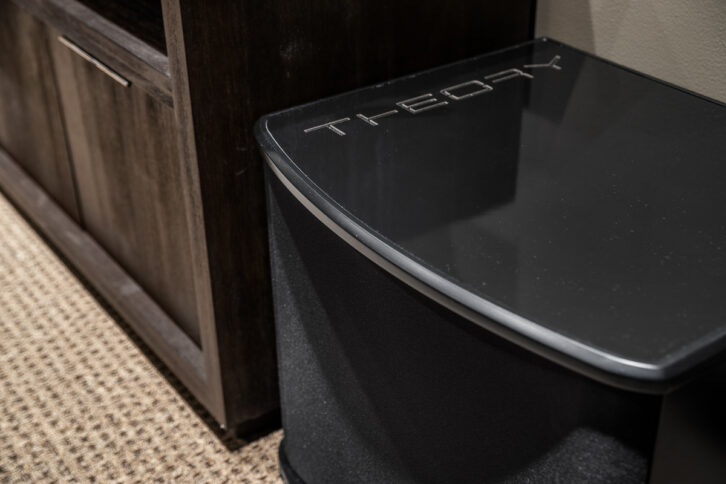
To securely hold its 68 pounds to the wall, Theory includes Z-clip mounts. These also hold the bar very tight to the wall, adding just .1-inch to its mounted depth. There is also an optional tabletop stand that increases the depth to 6.5-inches and adds about an inch to the height. Because my install was temporary, this is the route I took.
Though a single bar, it is essentially three separate speakers in one housing, so it requires three separate wiring runs for left/center/right, and the bar has three sets of recessed spring clips in back that accept up to 12-gauge wire.
Since I wanted to test the cohesion between the freestanding bar and Theory’s in-walls, I requested a pair of iw25 speakers for surrounds. I’ve previously built two freestanding “walls” that stand about 7 feet tall and feature 16-inch OC studs covered front and back with sheetrock and stuffed with insulation much like you’d find in a typical home construction, and I cut the speakers in a bit above seated ear height.
At nearly two feet high and ten inches wide and weighing 15 pounds each, the iw25 is a serious in-wall, and it includes an integrated backbox for controlled performance. The speaker can either run 4 ohms or Hi-Z (70V/100V with selectable taps), and has four wiring connectors protected under a terminal cover that allows you to wire multiple of them in parallel. With the ALC-1809, it runs in 4-ohm mode and only requires two wires. It also uses heavy-duty, non-strip Torx tensioning screws for tightening the six doglegs, allowing you to really secure it into the wall.
To fill in the bottom end, Theory sent two sub15s. (Honestly, my demo room could have easily used the sub12s, but when they offered the 15s, it would have just been rude to say no!) Regarding subs, Hales commented, “Two subs is always better than one because it helps reduce excitement of room modes, and when using two ALC units with Automator, you can create systems up to four subs. And four subs are better than two…”
As mentioned, Theory’s subs are a bit unusual in that they are passive, not requiring a power connection, and just needing a two-conductor speaker wire to each. With a cabinet crafted from solid HDF, the sub15 is formidable, weighing 76 pounds. The front is covered with black grille cloth, and the sides and top, with curved edges to soften its appearance, are finished in high-gloss black. As nice as it looks, at 21.3 x 23.5 x 19.8 inches there’s not much hiding it. Especially when there are more than one.
The final piece of the puzzle is installing the ALC-1809 and running the ALC Automator software. The ALC is a 1U component in a matte bright aluminum finish with a front-panel LCD display and two navigation buttons that you’ll likely never touch following initial setup. Around back are eight Euro audio input/loop connections (eight Euro-to-XLR adapters are included), as well as nine Euroblock loudspeaker output connections that accept the largest gauge wire you could possibly use. There is also a 12-volt trigger input with looping output. The ALC is fanless and silent should you need to place it in the listening room.
Before you go connecting inputs and speakers all willy-nilly, you need to download the Theory ALC Automator software and connect a computer to the ALC via a mini-USB cable. This program is designed for the fastest, simplest, and most — dare I say? — idiot-proof setup to get you from out-of-the-box to listening as quickly as possible.
The Automator software guides you through five steps, starting with specifying the speaker layout by selecting how many front, side, rear, and top speakers are in the system, along with subwoofers. A single 1809 can support virtually any system combination from 2.0 up to nine speakers in a 7.2 or Atmos 5.2.2 configuration.
Adding a second 1809 allows you to go up to 9.4.4 or 7.4.6 configurations. (Interestingly, when using two 1809s, the software utilizes one 1809 to power all speakers on the left and the other for the right side of the room.)
For larger systems, Theory has another programming application called Configurator that uses a more traditional approach where settings are done manually within the surround sound processor. Using this approach, the speaker limit would be that of the processor itself, which could be as high as 48 channels.
After specifying the layout, you enter in which model of speaker is being used at each location. For example, under front left/center/right, I selected the sb75 from the dropdown list. You then measure and enter the distance from the speaker to the listening position, from speaker to nearest wall, and from speaker to nearest corner. As you are making these selections, an on-screen graphic as well as wiring table will show you where to make connections to the ALC from your processor, and where to connect the speakers. This is crucial because of the way the amplifier channels operate inside the 1809 and how the Automator software configures them to maximize output. Amplifier channels 0-1-2 all have 300 watts into 4-ohms, and, in my system, were designated for the two subwoofers and the center speaker. Amplifier channels 3-8 are all 100 watts into 4 ohms, but bridgeable to 300 watts. Since I only had a 5.2 system, it automatically bridged channels 3-4 and 5-6 to deliver 300 watts to the front left and right speakers.
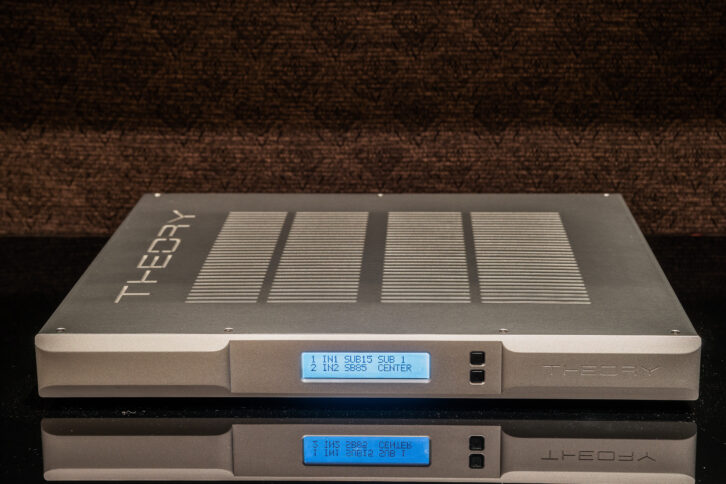
Once all selections have been made and the system has been wired as directed, you then apply the settings to the ALC, which programs the internal DSP and allows you to move onto step four where you can tweak subwoofer levels by +6/-12 dB, and then the final step is saving the settings to the ALC. The whole process is simple and intuitive, requiring nothing more than a tape measure, and takes less than 15 minutes.
Hales noted that he has plans for implementing future enhancements in the DSP that will include compensation for location of the main listening position (such as if you are seated in a corner, or near a back wall). These updates would be made available as a free firmware update to existing customers.
It’s important that the processor isn’t applying any correction, DSP, compression, or bass management ahead of the ALC. You want it simply to decode the surround information and act as a volume control. In my install, I set the Anthem’s speaker settings to large for the five speakers, along with a subwoofer. If you or your client prefers a bit of tweak on certain channels — say, bumping the center or surround levels — that can be done in the surround processor.
Room Correction
To say that Hales has strong and passionate feelings about the use of room correction would be an understatement. He sent me a lengthy response explaining his position on why he feels it is detrimental to the performance of his speakers, which I’ll summarize here.
“With so-called ‘room correction’ all you do is alter the acoustic response of the speakers in the system. My philosophy has been that you need to address the acoustic characteristics of the room in the acoustic domain, and the equipment and the electronics in the electronic domain.
“If you optimize the room acoustics and then you place the very best loudspeakers and audio components in that room, with the speakers aimed at you and nothing to grossly interfere with the speaker natural response, that’s going to be the best you can ever do.
“EQ can help if you have low-frequency standing wave problems, but it can only help a little. And EQ can improve things when it’s used to improve the direct response of a speaker at the listening position. However, EQ cannot make a reverberant room not reverberant. It can’t make a dead room not dead. It can’t make standing waves go away.
“On the Theory product, we’re not doing any ‘room correction’ as it relates to the reverberant response. We are, however, absolutely compensating for room-related changes to the speaker’s direct response; improving the direct response of the speaker at the listening area does have merit.
“Our approach is to design the most accurate speakers we can possibly design, and then ask you to put them in a room and try to mess with them as little as possible. We optimize the direct sound because it’s more important. Human beings tend to cue in on the direct sound, the first sound, the sound that gets to our ears first and the loudest.
“In Automator you answer three questions: what is the distance from the speaker to the chair, so that we can set levels and delays; what is the distance from the speaker to the nearest wall, so we can compensate for low-frequency gain of that wall; and what is the distance from the speaker to the nearest room corner — mainly for the subs — so we can account for the gain created by the corner in the subwoofer level setting.
“Theory Automator is asking where the room boundaries are and making adjustments for how those boundaries are affecting the sound that travels directly from the speaker to your ears, because that is what we humans care about most.”
Performance
After I’d made all the connections and configurations, I turned on my TV and 4K Blu-ray player. It just so happened that Dunkirk was in the tray, so I pressed Play to give it a listen.
I was immediately impressed with the fine detail and texture of sounds; the gritty scrape of the metal helmet on the concrete, the wind rustling with propaganda flyers blowing down the street. And then a window started banging open and shut, giving a hint of the massive dynamics to come, sonically raising the scene’s tension. Then came a series of gunshots that literally had me physically jumping in my seat. The dynamics and attack were so sudden, sharp, and powerful, they were nearly tactile and literally startling, as if someone had fired a weapon inside my listening room.
So, of course, I rewound the movie and then called to my 16-year-old daughter and told her I had something I wanted her to hear. And I played the opening again, this time watching her.
On the second viewing, even knowing the gunshots were coming, I still flinched, the speakers’ dynamics and output so visceral they triggered a fight-or-flight response. Oh, and my daughter jumped in her seat as well and called it terrifying.
If that isn’t what home theater is about, then you’re doing it wrong.
Getting further into Dunkirk, the Theory system continued to wow. From the shriek of fighter-bombers screeching overhead — even without any actual height channels — followed by the increasingly powerful concussive pounding as bombs exploded up the beach. During one scene I was holding my notebook in my hands, and I could feel the bass rattling into my chest and vibrating the paper almost as if it had a heartbeat of its own.
Mixing things up, I put in John Wick: Chapter 2 and skipped to where Wick is escaping the Roman catacombs. There is a moment before the action begins where it is mostly quiet, yet the room is filled with the air and space of the catacombs. Then Wick gets down to business, first with a pistol, then with a rifle, and finally with a shotgun. The Theory system delivers all these gunshots with the proper level of crack and intensity, but with clearly different sonics, building up to the shotgun where you feel the shells pounding you in the chest.
Any movies we watched with dynamic and explosive content produced far better-than-cinema audio that was startling, with bass that was powerful yet fully under control, but it was never at the expense of the small details or overwhelming the dialog. With the Theory system, you really feel like you are hearing exactly what the sound mixer intended, for good or bad.
We started the Apple TV series Silo, which is less about action (so far) and more about tension and atmosphere, and this gave the system a chance to display the terrific cohesion between the front bar and surround speakers, with no noticeable change in timbre or tone as sounds panned, echoed, or P.A. announcements filled the room from front to back. We forget just how impressive a properly setup 5.2-channel system can be, but the Theorys are quick to make you a believer again.
The sonic tone matching between front and back speakers really wraps you in sound and creates an amazingly convincing phantom channel between the front and back of the room, and also makes the overall width of the front presentation feel much larger than just the width of the sb75 bar.
This also routinely tricked my brain into being convinced there were sounds happening up overhead, even though there is no phase or steering trickery going on. (To be fair, the surrounds — positioned to the left/right of my couch — were about two feet above ear level.) I think it was the magic of the ALC-1809 along with the voice matching of the speakers that created this fantastic sonic bubble. Scenes like the opening of Kong: Skull Island where a dogfight happens overhead, or all the little whirs, clicks, and rattles inside the bomber at the beginning of Unbroken made me forget there weren’t actually speakers above me.
I was curious how the bar would do for music. I mean, as wide as it is, the left and right tweeters are only about five feet from one another. I listened to a fair bit of music, casting Tidal from my iPhone to the Anthem, and switched around from stereo, Anthem Music Logic, and Dolby Surround.
The same dynamics that impressed with movies were present with music as well. Songs like Lyle Lovett’s “Here I Am” or Michael Hedges’ “Aerial Boundaries” delivered those fast attacks that make music sound real and live. While adding the Anthem’s surround processing definitely helped with the spaciousness of the sound, the sb75 showed itself more than capable of delivering a compelling 2-channel experience. Listening to Sonny Rollins’ Go West: The Contemporary Records Album, you could clearly hear performers standing off far left and right, while still delivering a solid “phantom” center between them.
As I stated at the opening, this is simply the best “soundbar” surround audio system you can buy. But beyond that, this is just a fantastic-sounding system period, capable of delivering dynamics and output that is nothing short of cinematic and ferocious. And with similar performance throughout the line, you have the ability to choose the best speaker for the application without any fear of compromise. It really demands to be auditioned.
949-245-0505; TheoryAudioDesign.com
Product Specs:
- Theory systems require ALC-1809 amplified controller for proper operation
- ALC-1809 supports systems up to nine channels; two can be connected for systems up to 17 channels
- ALC-1809 features 1800 watts total power; channels 0-1-2 300 watts; channels 3-8 100 watts (bridgeable to 300 watts)
- sb75 includes six 5-inch Theory Carbon Fiber low-frequency drivers and three 1.4-inch Theory Advanced Polymer high-frequency compression drivers
- iw25 includes two 5-inch Theory Carbon Fiber low-frequency drivers and one 1.4-inch Theory Advanced Polymer high-frequency compression driver
- sub15 includes 15-inch Theory high-output woofer with 3-inch voice coil
- System is capable of incredible power handling and peak SPL output
- Setup is performed using Theory Automator software and a tape measure
- Surround processor required for operation
Dimensions:
- ALC-1809 — 1.75 x 17 x 15-inches (HxWxD); Weight: 13 pounds
- sb75 — 9.5 x 66 x 3.8-inches (HxWxD); Weight: 68 pounds
- iw25 — 23.5 x 9.63 x 3.4-inches (HxWxD); Weight: 15 pounds
- sub15 — 21.3 x 23.5 x 19.8-inches (HxWxD); Weight: 76 pounds
